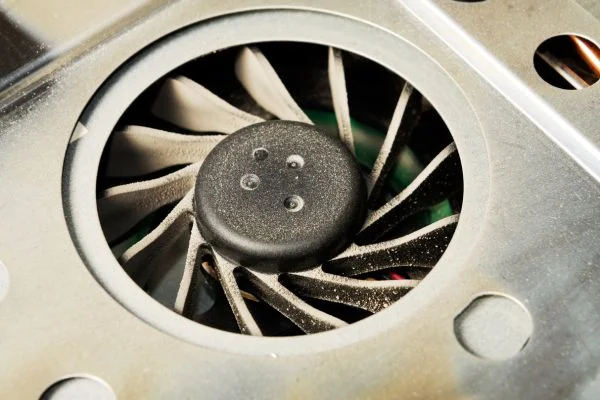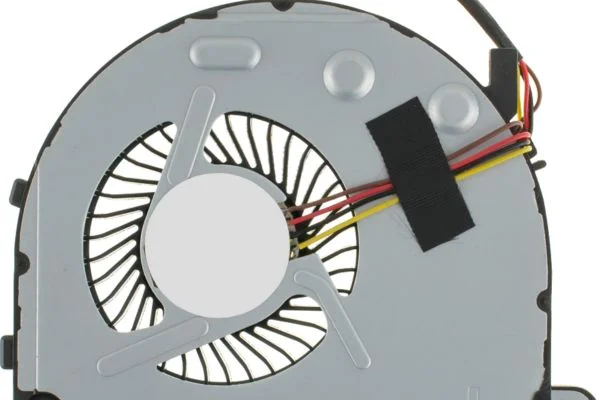A fan whirring inside your laptop can be distracting, especially when working in a quiet room. You may need to turn off the fan occasionally, even though fans keep your laptop cool. Maybe you’re watching a movie or presenting and don’t want the noise to disrupt your surroundings. In this blog post, we’ll take you through step-by-step instructions on How To Turn Off Fan On Laptop.
Understanding the Role of Laptop Fans
Laptop fans are critical in maintaining your device’s optimal performance and temperature. As laptops have become more compact and powerful, the internal components generate significant heat. Basically, it’s there to dissipate heat and prevent overheating. During resource-intensive tasks like gaming, video editing, or software that uses a lot of power, CPUs and GPUs generate more heat.

Read more about Why Does The Fan On My Laptop Keep Running?
The fan starts to circulate cool air and expel hot air from the system, maintaining a stable temperature.
The fan ensures that the components operate optimally by keeping the temperature safe. Heat can cause performance issues, system slowdowns, unexpected shutdowns, and permanent hardware damage.
CPU fans and GPU fans are the two main types of laptop fans. CPU fans cool processors, GPU fans cool graphics cards. Some laptops may have additional fans or heat pipes to dissipate heat more effectively.
Modern laptops employ smart cooling mechanisms that adjust fan speeds based on the system’s temperature. The fan speed can increase or decrease automatically to provide efficient cooling while minimizing noise.
If you want to save energy or reduce noise, you can turn the fan off temporarily. Turning off the fan may provide short-term benefits, like a quieter environment, but it’s not recommended. When the fan is turned off too long, excessive heat can build up, causing thermal throttling, component damage, and system instability.
Understanding the role of laptop fans helps us appreciate their importance in maintaining our devices’ overall health and performance. Balancing noise reduction, power conservation, and proper cooling is crucial to ensure your laptop’s longevity and optimal functioning.
Read more about How To Clean Gaming Laptop Fan?
How To Turn Off Fan On Laptop | Step By Step Procedure
Step 1: Open the Quick Link menu by right-clicking the Start button or pressing Windows + X.
Step 2: Select “Device Manager” from the menu to open the Device Manager window.
Step 3: Click the arrow next to “System Devices” to expand the drop-down menu.
Step 4: Scroll down and click on “System Fan Controller” to select it.
Step 5: Right-click “System Fan Controller” and select “Disable” from the context menu.
Step 6: Click “Yes” to confirm that you want to disable the system fan controller.
Step 7: Once the system fan controller is disabled, the fan on your laptop will stop spinning.
Note: It’s important to remember that turning off the fan on your laptop may cause it to overheat and damage internal components. Only turn off the fan if needed, and monitor your laptop’s temperature to prevent damage.
If your laptop doesn’t have a System Fan Controller in the Device Manager window, it may have a different method for turning off the fan. Some laptops have a fan control button or critical combo that lets you turn the fan on and off. Check your laptop’s manual or quickly search online to determine if yours has this option. Now if you know how to turn off fan on laptop and you want to another alternative then read next step.
Another alternative is to use third-party software that allows you to control the speed of your laptop’s fan. Be careful when downloading and installing third-party software, as it could contain malware. Make sure to download from a reputable source and scan for any issues before installing.
Read more about How To Make Gaming Laptop Fans Quieter?
General Tips To Keep Your Laptop Cool

Keeping your laptop cool is crucial for maintaining optimal performance and preventing overheating. Some tips to keep your laptop cool:
- Use a Cooling Pad: A cooling pad can improve airflow and dissipate heat from the bottom of your laptop. These pads often have built-in fans that provide additional cooling.
- Optimize Your Workspace: Ensure that your laptop has sufficient space around it for proper ventilation. Avoid placing it on soft surfaces like beds or couches, which can block airflow and trap heat.
- Clean the Vents and Fans: Over time, dust and debris can accumulate in the vents and fans, obstructing airflow. Regularly clean these areas using compressed air or a soft brush to maintain proper ventilation.
- Avoid Overloading the CPU: Running resource-intensive tasks for extended periods can strain your laptop’s CPU and generate excessive heat. Try to minimize multitasking and close unnecessary programs to reduce the workload.
- Adjust Power Settings: Lowering the performance settings on your laptop can help reduce heat generation. Adjusting the power plan settings to “Power Saver” or “Balanced” can limit the CPU’s maximum processing power and conserve battery life.
- Avoid Blocking Air Intake: Be mindful of how you position your laptop. Ensure that the air intake vents, usually located on the sides or bottom, are not blocked by objects or your hands while in use.
- Keep Software Updated: Regularly update your operating system and device drivers to benefit from performance optimizations and bug fixes. These updates often include improvements in power management and cooling efficiency.
- Use External Cooling Solutions: If your laptop overheats a lot, consider using external cooling solutions such as laptop cooling pads, external fans, or laptop cooling stands.
- Monitor Temperature: Monitor your laptop’s internal temperature with temperature-monitoring software. Observing consistently high temperatures could be a sign of an underlying problem.
- Give Your Laptop Breaks: If you are performing demanding tasks for an extended period, consider giving your laptop short breaks to cool down. Shutting it down or putting it in sleep mode can help prevent excessive heat buildup.
Bottom Line
So, How To Turn Off Fan On Laptop? Turning off your laptop’s fan can be helpful in some situations, but make sure you do it safely. Monitor your laptop’s temperature and only turn off the fan if necessary. This step-by-step guide will show you how to turn off your laptop’s fan. Check your laptop’s manual or consult a professional if you encounter any issues.

